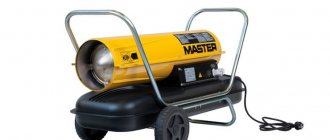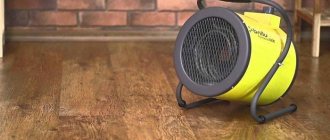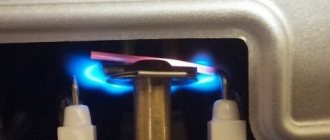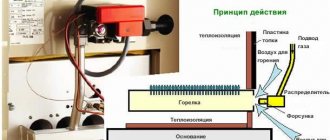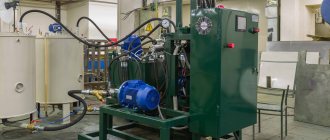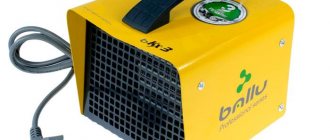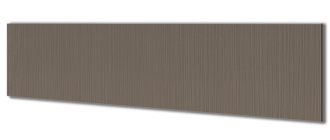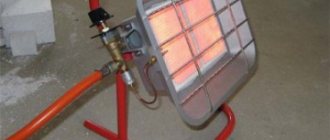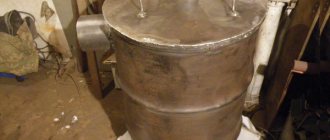In buildings that are not equipped or connected to a central heating system, a gas gun is often used to heat the premises. This mobile and easy-to-use device with a thermostat is able to quickly heat the air in the room and maintain a comfortable microclimate at a given level. Therefore, many owners of country and private houses, as well as industrial premises, prefer gas guns to their diesel counterparts.
Design and operating principle
Heating equipment of this class is used as a permanent or temporary heat source. In essence, a gas gun is a regular fan heater, but powered by gas, which, due to its design features, has a high level of efficiency and expanded functionality. The device releases warm air into the room, which is formed during the combustion of fuel.
The device is placed in a metal case, which has outlet openings designed to allow hot air to escape. Inside the body the heat gun contains:
- fan;
- burner;
- control device;
- heat exchanger;
- ignition device;
- thermostat.
In addition, additional elements can be placed inside the case, depending on the type of model and design features.
How does a gas gun work:
- A burner is placed in the combustion chamber, where gas is supplied.
- The device that provides ignition ignites the fuel, due to which the heat exchanger heats up.
- The fan draws in cold air and directs it back through the heat exchanger structure.
- Equipment protection from overheating and malfunctions is provided by a thermostat.
- When the air in the room warms up to the set point, the thermostat is activated and the switch breaks the electrical circuit, causing the gun to stop working. When the temperature drops a few degrees, the device turns on again.
This principle of operation of a gas heating device allows you to maintain an optimal microclimate in the room.
Gas-powered heat guns have a number of advantages. Among the most significant advantages are the mobility of the units, simple operation, as well as the affordable cost of units that operate with bottled gas. In addition, this type of heating device has a high efficiency rate with minimal electrical energy consumption.
Disadvantages of a gas heat gun
- Burning oxygen and releasing carbon dioxide indoors . Combustion of propane/butane is possible only in the presence of oxygen. By entering into a chemical reaction with it, water and carbon dioxide are formed. With poor ventilation or no ventilation at all, they accumulate in the room. It turns out that the concentration of oxygen decreases, and carbon dioxide increases. As a result, people's health worsens, blood pressure rises, and headaches appear. The problem is solved with the help of a constant flow of oxygen and outflow of carbon dioxide.
- Great price for an indirect heating gun . The cost is 2-2.5 times higher than for a direct heating gun of the same power. The design of such a device is more complex, so it is more expensive.
- Noisiness . The fan and burning gas make noise during operation. This creates a constant noise load, which should not exceed 40 dB in a room with working people. Powerful gas and diesel guns produce up to 80-90 dB. Electric is considered the quietest.
- Connection and configuration require specialist consultation . Gas-powered equipment is connected in accordance with regulations and checked by a gas service specialist. Propane/butane is supplied to the gun from a gas pipeline or cylinder through a gas hose. All fastenings must be secure. Before switching on, it is necessary to monitor the gas pressure, tightness, and serviceability of the equipment.
- The need to supply electricity to the installation site . The electric motor of the gas gun fan operates on alternating current 220 V or 380 V. The length of the cord with a plug is limited, so the device cannot be installed in a room without an outlet or far from it.
Types of gas heat guns
Gas heating guns come in two types, depending on the fuel consumed. Some operate only on liquefied gas, which is in a cylinder - propane or butane. The second type of device is universal and can operate on any type of gas, because their body contains an element that ensures pressure stabilization. The presence of this component allows you to connect the device directly to the gas main.
Depending on the type of fuel consumed by the device, it may have certain characteristics. The gas pressure in the general network varies between 0.015-0.02 MPa, so the devices are designed for different inlet pressures. But at the output, the reducer installed on the gas cylinder has an indicator of 0.036 MPa.
The differences between these types of units also affect the nozzles, which may have different nozzle diameters, because the calorie content of natural and liquefied gas is significantly different. Bottled gas is three times more calorific than main gas, so if the functions of the gun do not include the use of main fuel, then you should not connect to it a heater designed only for bottled liquefied fuel.
Attention! During the operation of a heat gun, oxygen is necessarily burned out. Therefore, these devices are not recommended for use in rooms without a ventilation system. This is life-threatening!
Based on the type of construction, there are only two types of these devices: gas gun of indirect heating and direct. Let's look at the features of each variety.
Direct heating device
The design of a direct-heating gas gun is not equipped with the function of purifying air flows from burning, so in residential areas they can poison oxygen. This is the only but very significant drawback of these devices, which forces consumers to make a choice that is not in their favor.
At the same time, direct heating units have an efficiency of 100% and during their operation consume a minimum amount of fuel and electricity.
The design of direct heating equipment is quite simple: a fan and a burner are placed inside the housing, heating cold air currents, and the fan blows them into the space, creating a powerful stream of air.
Indirect heating device
A gas heat gun with indirect heating uses a ring-type heat exchanger as a heating element. The working process of these devices differs from direct models in that fuel is first burned inside the housing, and then toxic products that are released as a result of the combustion process. Therefore, this type of guns is considered environmentally friendly and absolutely harmless to human health.
For obvious reasons, devices with indirect heating are popular among consumers for heating homes. Installation of such guns is allowed even in rooms with poor ventilation systems.
However, this design also has one, but very significant drawback - the presence of a chimney pipe in the body, which reduces the mobility of the device and creates difficulties in its transportation.
Note! Compact models of guns powered by natural gas are very economical. The unit consumption is only 1 l/h.
Operating principle, types
This is equipment for heating indoor air, on sites, in which thermal energy is generated by the combustion of liquefied gas, usually propane or butane.
The gun consists of the following elements:
- A fan that blows cold air.
- Gas-burner.
- Ignition.
- Heat exchanger.
- Thermostat.
- Electric motor.
- Control system.
The fan is brought into operation using an electric motor . It forces cold air inside the device. Then, using a torch, electric ignition or piezoelectric element, the gas is ignited. Hot air flows under pressure come out and heat the room. Most modern guns have a thermostat that allows you to regulate the heat supply.
Gas guns are:
- Portable - small in size, have a handle for carrying, low power, used for heating small areas.
- Mobile – have wheels or a stand on wheels.
- Stationary – permanently installed in premises with a large area (trading floors, workshops, warehouses).
Direct heating heat guns are in great demand. They work like gas burners, quickly heat the air, but burn oxygen and emit harmful combustion products directly into the room.
Expensive, bulky and less popular - indirect heating , which has a chimney. It removes gas combustion products outside the room. Therefore, the device does not pose a threat to human health.
Areas of application of gas guns
The popularity of gas heat guns is determined by their safety, practicality and wide range of applications. These devices are used not only for heating living rooms, but also for domestic needs: drying objects with large dimensions, as well as for ventilation of rooms.
Operating a gas gun in a garage will create conditions for normal starting of the car, as well as performing repair work. In addition, the gas gun is in demand not only in domestic conditions, but also in production. This equipment is used for high-quality and economical heating of greenhouses, greenhouses where vegetables, seedlings and flowers are grown.
A gas gun is an autonomous heating device, but it can also become a structural element of an entire installation, which is designed to maintain the necessary microclimate in the room. Structures that run on natural gas can be used to heat automotive, agricultural and specialized equipment.
The capabilities of this device are often used during repairs, when it is necessary to quickly dry walls after puttying. In addition, this type of equipment is used when installing suspended ceilings, since the fan built into the structure speeds up these processes.
In addition, the functionality of a gas heat gun will be useful in large areas, the size of which exceeds 25 m².
Operating principle and application of a gas gun
If you connect the gun to a centralized gas supply, it turns into a full-fledged stationary device, which in a private home can easily replace an entire heating system without any damage to the quality of heating. Regarding the fuel used, in most cases it is propane-butane.
Note! When the gas burns, virtually no odor is released.
Moreover, the multi-level protection system found in the devices completely eliminates gas leakage. More “advanced” models have a special body coating that protects it from damage.
Thanks to gas guns, you can not only heat, but also quickly dry any surfaces - for example, plaster, freshly poured concrete, etc., and high performance makes it possible to use the device in large rooms - warehouses, hangars - and in crowded places. This device really can be set and forgotten, because temperature control and on/off is initiated by the thermostat. Finally, in terms of the amount of carbon monoxide, a gas gun does not exceed a regular stove.
Read about how else you can heat industrial premises here
All devices of this kind consist of standard elements:
- heat exchanger;
- automatic device-controller;
- fan
It is characteristic that the device requires very little electricity - after all, it is only needed to rotate the fan. When the gas burns, the heat exchanger warms up. The air driven by the fan passes through the heat exchanger, heats up and spreads throughout the heated room.
How to choose a gas heater?
To select a device with suitable parameters, the following characteristics must be taken into account:
- the material from which the building is constructed (brick, stone or metal);
- quality of thermal insulation (types and features of internal and external insulation);
- the absence or presence of electrical wiring in the room (the gun will not be able to work without electricity);
- features of the ventilation system;
- total area of the room;
- operations that take place indoors.
- manufacturer and level of product quality;
- gas gun body shape;
- heating method (direct or indirect);
- unit power level;
- dimensions of the device.
In addition, it would be a good idea to read reviews from other consumers who have already purchased and used the device.
Making a heat gun - instructions
Next, we’ll look at several popular models of heat guns and DIY methods.
Gas heat gun
A gas heat gun is an effective and economical way to heat large areas.
There are 2 main types: stationary, connected to a gas pipeline, and mobile, for which cylinders are used. Mobile options are used by builders when working in winter; they are used in greenhouses and garages. According to the heating method, they are distinguished:
- Direct heating devices, when the gas from the burner directly enters the fan, and then into the room. The efficiency of such a heat gun is about 100%, although it is not the healthiest.
- Indirect heating devices. Here the gas is heated by a special heat exchanger, and the combustion products go into the chimney, just like in a gas boiler. The efficiency of such a heat gun is lower, but it can be used in residential premises without fear.
To create a simple heat gun of the first type with your own hands you will need:
- An old gas or welding cylinder or thick-walled pipe.
- Fan.
- Gas nozzle with divider.
The bottom of the cylinder is cut off.
A burner and ignition device are installed inside.
A fan is attached to the outlet.
Gas hose and electrical cable are supplied.
The supports are welded or screwed on so that the heat gun does not lie on the floor.
After testing, the device is ready for use.
Electric heat gun
The design of an electric gun is not very different from a gas gun, only heating elements are installed instead of a burner.
Basic assembly aspects:
- The length of the pipe for the housing is taken from the calculation of the length of the heaters and the distance of at least 20 cm between them and the fan.
- The wiring of heating elements and fans must be autonomous, with mandatory grounding.
- A thermostat is required to increase/decrease heating.
- Ideally, protection against overheating is needed.
When assembling and operating an electric heat gun, it is important to follow safety rules when working with electric current.
Heat gun on diesel fuel and diesel fuel
This is the most dangerous type of heat gun, so assembly requires increased care and attention.
The housing will require a sealed tank, which will be divided into a heat exchanger and a combustion chamber. The ideal option would be an old wood-burning boiler or stove.
Using a pipe, burning diesel fuel enters the chamber from the burner and passes through the heat exchanger. Combustion products are removed into the hood.
The fan forces cold air into the housing, creating a flow of heated air from the nozzle.
Wood fired heat gun
A wood-burning heat gun is similar to a diesel heat gun, but is somewhat safer and smells significantly less. In the combustion chamber, instead of a pipe and a burner, a door for firewood, an ash pan and grate bars are installed. A wood-burning gun is heated similarly to a wood-burning boiler, the only difference is the presence of a fan.
Frequent breakdowns and their elimination
Common problems with gas guns and possible causes:
- If the flame goes out when the forced fuel supply button is released, this may indicate a breakdown of the safety sensor.
- There is no ignition when gas is supplied - there may be no spark in the design, so adjustment of the piezoelectric element may be required.
- The fan operates without fuel supply - this sign indicates a malfunction of the solenoid valve.
- It is not possible to adjust the fuel supply while the device is operating - most likely, the gas line is clogged.
- During operation, a strong smell of carbon monoxide appears - the device requires cleaning and adjustment of the gas pipeline on the heat generator. You must immediately turn off the equipment and under no circumstances continue to use it.
Important! It is better not to risk trying to repair the device yourself. All repair work should be performed by a professional.
How to make a gas gun with your own hands?
If your knowledge and experience allow you to make such a complex heating device yourself, then you can make an indirect heating gas gun with your own hands.
To make the device you will need:
- two pipes 1 m long and with a diameter of 18 cm (body) and 8 cm (combustion chamber);
- pipe with a diameter of 8 cm and a length of 30 cm (outlet pipe);
- axial type fan with round flange;
- gas burner equipped with a piezoelectric element.
Before you start creating a device, you should carefully study the diagram, which will become a guide during the work process.
Do-it-yourself gas heat gun manufacturing technology:
- First you need to take a pipe with a large diameter and make a couple of holes. The size of one of them is 8 cm. An outlet pipe for heated air will be attached to this hole. The size of the second is 1 cm. This hole will be used to fix the gas hose. You need to make a combustion chamber from a pipe with a diameter of 8 cm.
- Then you need to assemble the plug. It can be cut from a sheet of metal. This part must cover the gap between the housing part and the combustion chamber. In this case, it is very important not to block access so that it is possible to connect the structure to the chimney.
- After this, all the elements come together. To do this, you will need a welding machine and skills in handling it. The combustion chamber along with stiffeners is welded inside a large pipe. A pipe and a plug are fixed from the outside. Through this element, heated air will enter the room. All that remains is to install the gas burner and fan. All elements must be firmly fixed.
Helpful advice! To keep the combustion chamber firmly in the central part of the housing, it is better to use plates that are welded to the pipe.
The process of assembling a direct fired gun is much simpler. Such a device consists of a pipe, at one end of which a fan and burner are attached. Combustion products and hot air flows will come out from the opposite side.
How does a gas gun work?
Home / All about heating / Heating boilers / How a gas gun works
March 31, 2015
With the arrival of cold weather, the issue of heating a room becomes very relevant. For these purposes, various types of equipment are used, among which gas guns have become widely popular. This type of heating is simply an ideal option for country houses, as well as country houses.
| Good to know Types of gas guns How to make a gas gun How does a gun with a gas pressure regulator work? How a homemade gas gun works (video) | Pros of a gas gun In order for this device to turn into a full-fledged heating unit, it will be enough to connect it to a centralized gas supply. Fuel consumption can vary from 0.6 to 7 l/hour. |
Scheme of operation of a gas gun
How does a gas gun work and where is it used?
In order for this device to turn into a full-fledged heating unit, it will be enough to connect it to a centralized gas supply. As a rule, propane-butane is used as gas. Since the gas does not emit virtually any odor during combustion, this installation is absolutely safe. Gas leakage is practically impossible due to the fact that the installations have a multi-level protection system.
An important feature of gas guns is that with their help you can not only heat a room, but also dry various surfaces. These include concrete surfaces, as well as plaster and other surfaces. Due to its high efficiency, the device can be actively used in large areas, warehouses, hangars, etc. A distinctive feature of the device is its autonomous operation, thus the heating temperature is regulated using a thermostat.
Gas gun design
The device consists of a number of elements, among which we should highlight: a heat exchanger, an automatic controller and a fan. The device only needs electricity to rotate the fan, and therefore very little of it is used. Due to gas combustion, the heat exchanger is heated. The air masses, under the influence of the fan, pass through the heat exchanger and, heating up, spread throughout the entire room.
Types of gas guns
With direct heating method
A design feature of the first type of gas guns is that the gas burner in them is not insulated at all. Due to the very high efficiency, the air in the room warms up perfectly; at the same time, combustion products also enter the air, and therefore the room must have excellent ventilation.
With indirect heating method
Guns that use an indirect operating principle have special combustion chambers. Special pipes are connected to these chambers, through which combustion products are discharged into the chimney. This type of equipment will be the optimal solution for heating rooms with a large number of people. The information provided applies to a greater extent to guns of a stationary type and, as a rule, factory-made. However, in addition to them, there are also portable mobile gas guns. Their kit includes a gas cylinder. For ease of use and transportation of the device, wheels and handles are mounted on it.
When using mobile guns, you must strictly follow all safety rules! The operating time of such equipment will depend on the volume of the gas cylinder. Regarding fuel consumption, it can fluctuate and be from 0.6 to 7 l/hour. Also, using special adapters, the device can be simultaneously connected to several gas cylinders, which will increase its operating time. Among the types of equipment you can find guns with thermostats. This type is considered the most economical. In this case, the device will turn off when the set temperature is reached.
How to make a gas gun
To create a gas gun we take:
- a metal pipe to supply fuel to the system;
- drill and metal drills; grinder; steel sheet;
- metal strips two millimeters wide;
- a metal pipe 8 mm thick to create a heat exchanger;
- car fan with a minimum power of 12 V;
- reinforcement for the construction of the structure itself.
First of all, using a grinder, you need to cut the pipe, since gas will flow into the system through it. To extend the pipe, it is necessary to weld another one of the same diameter to it. The hole should be enlarged so that it is about five millimeters and the jet should be lengthened by two mm. The body of the device should be made longer; for these purposes, you need to take an 8 cm metal disk and secure it under the extension cord itself. Then you need to drill eight holes 1 cm.
It is necessary to make a clamp with which the heat exchanger will be attached. Next, you need to take two metal plates and weld them crosswise. This will significantly increase heat transfer.
Heat exchanger manufacturing
For these purposes, an iron pipe 8 cm long with not very thick walls is useful. Next, you need to weld the end onto the pipe wall and drill a hole in it. The extension cord from the burner will pass through this hole, and the clamp will need to be secured with bolts. The next step is to continue assembling the heat exchanger. Using a grinder, a hole is made in the heat exchanger and an 8 cm tube is attached to it, through which hot air will flow into the room.
You need to take a car fan and mount it on the second end of the exchanger housing. Thanks to the fan, heated air will be supplied to the room. At the final stage, it will be necessary to drill holes through which the gas can be ignited. Also, for this you need to worry about the structure on which the gas gun will be attached. You can use a frame made of iron reinforcement for these purposes.
How a gas gun with a gas pressure regulator works (video)
Test run
Before operating the equipment, it is necessary to carry out a number of preparatory work.
- Light a lighter through the hole in the firebox.
- Start the gas supply by opening the valve.
- After the gas ignites, the lighter should be put back.
- Turn on the car fan.
If everything is done correctly, the device can be put into operation.
Briefly, the manufacture of a gas gun will look like this:
- a metal extension disk should be secured to the burner;
- it is necessary to extend the pipe in order for gas to flow into the device;
- for good heat transfer, iron plates should be installed;
- install a clamp on one side of the extension and secure the heat exchanger itself;
- assemble the burner device;
- holes should be made in the heat exchanger to allow hot air to escape through them;
- a metal ring should be welded to the other end of the pipe;
- install a switch on the heat exchanger to turn on the fan;
- assemble the fan.
The body of the gun has the shape of a pipe, and therefore you need to take a thin piece of steel, cut it to size and roll it into a pipe.
How a DIY gas gun works (video)
Advantages of a gas gun
- High safety of the device;
- Minimum time for installation and dismantling work;
- Minimum time to prepare equipment for operation;
- Compactness and excellent ergonomics of the device;
- Rapid heating of air throughout the room;
- Possibility of self-adjustment of heating temperature;
- Very high efficiency rates.
Photo: gidotopleniya.ru, v-teplo.ru, pl41.com, remonti-ka.ru
Interior design: specific features and important nuances
We are building a wooden fence!
Advantages of Vulcan original
Modern window design
Safety precautions when operating a gas gun
A gas heat gun is very simple to use. If you follow the rules of its operation, the equipment will not pose any danger to human life or health.
Basic safety rules when operating a gas heat gun:
- Do not dry shoes, clothes and other items on the device body, as well as any actions during which the air duct or air collector may be blocked.
- The device housing and fan must be protected from moisture.
- It is imperative to use wiring with a power corresponding to the technical parameters of the device.
- Do not operate the unit in a dirty room with a high concentration of dust.
- In a building where a direct heating gun is used, it is necessary to organize good ventilation.
- Do not place hazardous or flammable substances close to the device.
- The area where the gas hose is attached to the fuel cylinder must be checked for complete leaks. Leaks are not allowed.
- The gas is much heavier than air, so it can accumulate at the bottom of the room, creating an explosive situation. Therefore, it is prohibited to operate gas guns in rooms that are below ground level.
Before turning on the device, you need to read the operating instructions, which describe all the nuances of connecting and using the device.
Thus, a gas gun for heating rooms is an economical, safe and compact device with high efficiency, therefore these devices are considered the best way to heat air in buildings with different areas and large volumes. Such units can become an alternative to the standard heating method.
Installation and connection of a heat gun
The method of connecting the heater depends on the type of its drive. There are also general operating rules that must be followed when connecting any heat gun.
General rules for operating a heat gun:
- Place the device only on a flat surface.
- It is advisable to leave a gap of at least one and a half meters from the ceiling to the cannon.
- Do not lean the back of the heater against walls or other objects.
- Do not cover the heat gun nozzle. This reduces its effectiveness and increases the risk of overheating and even fire. It is advisable that there be at least three meters of empty space in front of the outlet.
- Do not attach any sleeves to the gun nozzle.
- Do not place any objects on the heat gun.
- Do not move the heat gun while it is on.
- Do not point the heat gun at flammable objects.
- Do not use a heat gun in places where there are vapors of flammable or explosive substances: gasoline, acetone, alcohol, etc.
- Do not turn on the heat gun in places where there is a lot of dust.
- Do not use the heater in areas with high humidity or outdoors during rain.
- Do not leave the heat gun running unattended.
- Do not make any changes to the design of the heat gun.
- During repairs, use only the parts specified in the instructions.
- If you want to disassemble, refuel or repair the heater, you need to turn it off and unplug it.
- If you use the heater indoors, do not forget to ventilate it at least occasionally.
- If the heat gun is dirty and dusty, then it needs to be cleaned before turning it on.
- Before using the device at full power, allow it to warm up for an hour or two. This is especially important in winter when working outside or in cold rooms.
